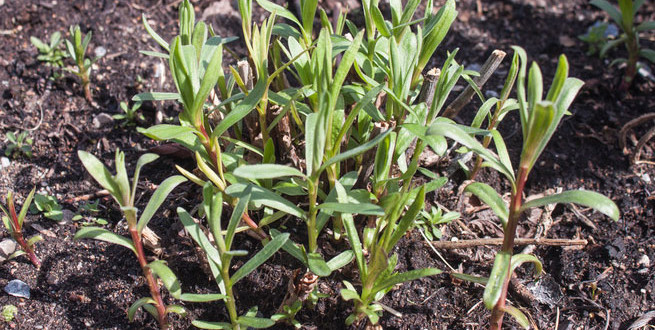French Tarragon
French tarragon (Artemisia dracunculus ‘Sativa’) is a frost sensitive perennial with dark, slender aromatic leaves on long stems growing 18 to 24 inches tall. Tarragon rarely flowers or produces seed — it slowly spreads roots underground. Cuttings or divisions are used to propagate the plant. Tarragon is prized by chefs for its sweet, delicate anise flavor.
Beware of its imposters — Russian Tarragon has no flavor and is not a true culinary tarragon. Mexican tarragon is not tarragon at all, but rather a marigold (Tagetes lucida) grown as an annual. However, unlike Russian tarragon, Mexican tarragon can stand in for French tarragon in a pinch since its leaves have aromatic oils similar to those of French tarragon.
When in doubt of the true culinary tarragon, taste a leaf: French tarragon will tingle on the tongue and impart a sweet anise flavor.
How to Plant
Plant French tarragon in full sun or partial shade in a loose, well drained, sandy loam soil enriched with organic matter at 9 inch intervals. Like most herbs, French tarragon prefers soil with a neutral pH. Surprisingly, tarragon is quite drought tolerant. It also does well in a container or hanging basket where it drains well and has good air circulation. Plant tarragon in an areas were it will get some shelter from hot afternoon sun. Tarragon is susceptible to root rot, so do not over-water.
Divide the tarragon every three years to keep plants vigorous and flavorful.
Fertilizing
French tarragon is a light feeder; foliar spray plants with compost tea or a seaweed extract 2 to 3 time during the growing season.
Harvesting
Wait about two months after planting tarragon to begin harvesting leaves. Pick young, top leaves in early summer for best flavor. Cut back leafy top growth several times during the season to encourage the plant to bush out with new growth. To dry tarragon, hang the branches upside down in a warm, airy spot, then strip the leaves into a jar and close the lid tightly.
Recommendations for Use
- French tarragon is a traditional seasoning with eggs, poultry, salads, cheese, shellfish, and fish.
- Tarragon is used in herbal blends such as fines herbes and bouquet garni
- Tarragon is the key ingredient for Sauce Béarnaise
- French tarragon makes an excellent herb-flavored vinegar used for salad dressings
Recipes: Green Goddess Dressing

